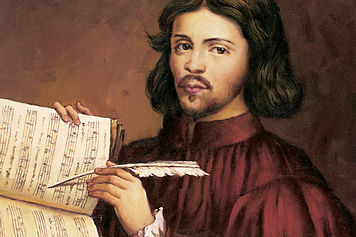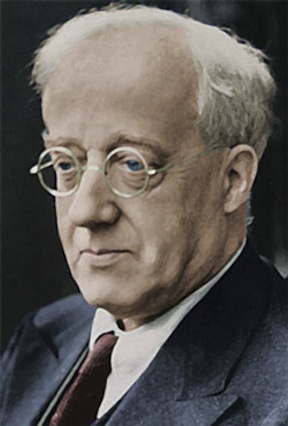The Well-Tempered Ear
Classical music Q&A: Choral director Robert Gehrenbeck talks about his favorite works by British composer Ralph Vaughan Williams. You can hear some of them when the Wisconsin Chamber Choir — which unveils its 2014-15 season here — performs works by Vaughan Williams and his followers this Saturday night. Part 2 of 2. | May 30, 2014
By Jacob Stockinger
This Saturday night, the Wisconsin Chamber Choir (below) will wrap up its current season with a special concert of “Ralph Vaughan Williams and Friends.”
The concert is at 7:30 p.m. on this Saturday, May 31, in the acoustically resonant Grace Episcopal Church, West Washington Avenue at Carroll Street on the Capitol Square, downtown Madison.
The soloists include violinist Leanne League and organist Mark Brampton Smith.
Admission is $15, $10 for students.
One of the best-loved choral composers, Ralph Vaughan Williams was renowned not only for his compositions, but also for his friendship and advocacy on behalf of countless other musicians.
The concert features some of Vaughan Williams’ best-known works including, “Serenade to Music,” Mass in G Minor, and the powerful anthem, “Lord, Thou Hast Been Our Refuge.”
Vaughan Williams shared a passion for collecting folksongs with his close friend Gustav Holst, whose heartfelt setting of “I Love My Love” will be heard alongside several of Vaughan Williams’ own folksong arrangements.
Works by Herbert Howells and Vaughan Williams’ students Imogen Holst and Elizabeth Maconchy will demonstrate Vaughan Williams’ influence on succeeding generations.
Finally, selections from the motets and anthems of Thomas Tallis exemplify Vaughan Williams’ debt to his English predecessors, notably Tallis’ “Third Mode Psalm Tune,” the inspiration for Vaughan Williams’ “Fantasia on a Theme by Thomas Tallis.”
Joining the WCC in this performance are violinist Leanne League, associate concertmaster of both the Madison Symphony and the Wisconsin Chamber Orchestra; and organist Mark Brampton Smith.
Advance tickets are available for $15 from http://www.wisconsinchamberchoir.org, via Brown Paper Tickets, or at Willy Street Coop (East and West locations) and Orange Tree Imports. Student tickets are $10.
Founded in 1998, the Madison-based Wisconsin Chamber Choir has established a reputation for excellence in the performance of oratorios by Johann Sebastian Bach, Wolfgang Amadeus Mozart, and Franz Joseph Haydn; of a cappella masterworks from various centuries; and of world-premieres. Dr. Robert Gehrenbeck, who teaches and directs choral activities at the University of Wisconsin-Whitewater, is the Wisconsin Chamber Choir’s Artistic Director.
Gehrenbeck recently agreed to an email Q&A about the upcoming concer.
Yesterday, Part 1 appeared. Here is a link to Part 1:
Today’s post features the second and last part of the Q&A.
What are your favorite works –- choral or otherwise — by Vaughan Williams, ones you would recommend to those listeners who don’t know him?
Many discussions of Vaughan Williams’ body of works start with his visionary orchestral work, the “Fantasia on a Theme by Thomas Tallis” from 1910. The “theme” of this work is a choral psalm tune in the Phrygian mode by Tallis (below) that Vaughan Williams discovered while working as music editor for the 1906 “English Hymnal.” (The WCC’s concert includes this Tallis work in its original form, using words from the English Hymnal.)
Not only did Vaughan Williams borrow Tallis’ melody, but, more importantly, his harmony, which is full of jarring cross relations, such as E-minor juxtaposed with E-major. Throughout his “Fantasia” — and throughout his career —Vaughan Williams exploited and extended this harmony based on what I like to call “consonances in unusual relation” (that’s a quote from the Grove Dictionary article on an obscure English composer named Alan Bush).
Unlike his contemporaries who developed increasingly chromatic music around the same time, Vaughan Williams stuck with simple triads but subjected them to various sorts of modern treatments, especially by juxtaposing seemingly unrelated chords, as in the 1910 Fantasia.
Finally, the form of this piece is not, as one might expect, a theme and variations scheme, but rather a free, rhapsodic meditation on the ethos of Tallis’ tune, somewhat in the style of an Elizabethan keyboard fantasia by William Byrd.
So it is that in this work, we have the characteristics of Vaughan Williams’ mature style in a nutshell — a melody-based form that develops freely, rather than predictably, whose harmonic language is based on new, modally inspired ways of using common chords.
The overall effect is mysterious, awe-inspiring, and revelatory. The young Herbert Howells (below) was so awestruck by the premiere performance that he spent the rest of the night pacing the streets of Gloucester, trying to digest what he had heard.
As I mentioned above, Vaughan Williams wrote nine symphonies, and several of these are favorites of mine, particularly the first, sixth, and ninth. His first symphony is a choral-orchestral masterpiece (following the examples of Ludwig van Beethoven, Felix Mendelssohn and Gustav Mahler). It’s called “A Sea Symphony,” with a libretto based on the poetry of Walt Whitman (below).
Completed the year before the Tallis “Fantasia,” this score gives voice to the muscular, optimistic humanism of Whitman’s poetry in triadic eruptions that stir the soul. I don’t claim to know all of Vaughan Williams’ music by any means, but, like many others, I am also a fan of his sixth symphony, composed in the aftermath of World War II and premiered in 1948, soon becoming the most popular English symphony of all time. The change in Vaughan Williams’ style during the 40-year period between his first and sixth symphonies is startling.
The sixth provides a good rebuttal to those who claim that Vaughan Williams remained a reactionary, rather than a modern composer. It’s full of dissonance and gnawing ostinatos that create an atmosphere of unease and dislocation, which seemed to fit the post-Hiroshima age — including our own times — extremely well.
The long final movement is marked “pianissimo, senza expressivo” (very quietly, without expression) throughout, eventually dissolving into a weird undulation between two unrelated triads, E-flat major and E-minor. Such a concluding movement is exactly the opposite of what traditional symphonic form leads listeners to expect. It’s one of the most eerie moments in the entire symphonic repertoire.
I’m afraid I’ll have to save a discussion of other orchestral works for another day, but I do want to mention a few additional favorite choral works: the war-time oratorio “Dona Nobis Pacem” (another Whitman libretto), the rarely heard oratorio “Sancta civitas” (libretto from the Book of Revelation), and the late “Three Shakespeare Songs” for unaccompanied choir. Several other favorite works of mine are on the WCC’s concert, so I’ll discuss them next.
What would you like the public to know about the specific composers and works on the program, and why you chose them?
We are looking forward to performing what I think is Vaughan Williams’ most inspired setting of William Shakespeare, his “Serenade to Music,” composed in 1938. Vaughan Williams adapted his libretto from Lorenzo’s meditation on the power of music to mediate between human passion and the harmony of the spheres in “The Merchant of Venice,” Act V
“How sweet the moonlight sleeps upon this bank!
Here will we sit and let the sounds of music
Creep in our ears: Soft stillness and the night
Become the touches of sweet harmony….
Thus begins Vaughan Williams’ one-movement nocturne featuring some of his most lovely melodies, exquisite modulations, and ethereal scoring. The original version was for 16 solo singers and orchestra, so we will alternate between multiple soloists from the choir with the full chorus singing the tutti passages. Our fabulous organist, Mark Brampton Smith (below top), is responsible for most of the orchestration, Leanne League, who is the associate concertmaster of the Madison Symphony Orchestra and Wisconsin Chamber Orchestra and a violinist with the Ancora String Quartet, is joining us to perform the original solo violin part. (You can hear “The Serenade to Music” in a YouTube video at the bottom.)
The remainder of our program draws on the rich a cappella repertoire of Vaughan Williams and several of his followers.
We’re doing two movements from his incredible Mass in G minor, which he wrote in 1921 in response to the revival of the sacred music of Byrd and Tallis at Westminster Cathedral. We’ll precede that work with an actual motet by Tallis, “Mihi autem nimis.”
In addition to the Serenade, the second half of our program features folk song settings by both Vaughan Williams and his closest friend, Gustav Holst (below), including Holst’s justifiably famous “I Love My Love,” based on a Dorian-mode tune. This piece is one of the absolute masterpieces in the genre of choral folksong arrangements.
From Vaughan Williams’ numerous additional “friends” (composers who were all literally good friends of his) we have chosen Herbert Howells, Gustav Holst’s daughter Imogen Holst (below top) and Elizabeth Maconchy (below bottom). Howells is represented by the “Jubilate” movement from his “Collegium Regale Service,” a set of Anglican canticles he composed in 1945 for King’s College in Cambridge.
The flowing melodies, modally flavored harmonies and Howells’ expert control of pacing in this work are all reminders of Vaughan Williams’ influence. Imogen Holst (below) was the only child of Gustav and Isobel Holst, and an important composer, conductor, writer, and organizer of musical festivals in her own right. Her teachers included both Howells and Vaughan Williams, and she became closely associated with Benjamin Britten during her later years.
We will perform Holst’s “Hymne to Christ,” a luminous setting of a poem by John Donne.
Finally, Elizabeth Maconchy was another of Vaughan Williams’ students and a classmate of Imogen Holst. Maconchy (below) is best known for her chamber music, but also composed operas and a significant body of choral music. We have chosen two movements from a 1979 work called “Creatures,” settings of poems written for children about various animals and their foibles.
The music of “Cat’s Funeral” is an example of the English predilection for “consonances in unusual relation” that I mentioned earlier. The string of unexpected, descending minor triads that opens this movement creates a mood of exaggerated pathos perfectly matched to the poem. The other movement is “The Hen and the Carp,” a humorous dialogue that doubles as social commentary.
What are the current plans and future projects including programs for next season, for the Wisconsin Chamber Choir?
We are very excited about our upcoming season. On December 19, 2014 we will present “Wolcum Yole,” a Christmas-themed concert featuring Benjamin Britten’s “Ceremony of Carols,” and on April 18 and 19, 2015, we will perform Brahms’ “German” Requiem with full orchestra. Also featured on the April concerts will be the world premiere of a piece we have commissioned from English composer Giles Swayne, called “Our Orphan Souls.” Swayne has chosen an excerpt from chapter 114 of Herman Melville’s “Moby Dick” as his text, and his piece will be scored for two soloists and choir with alto saxophone, harp, double bass and percussion.
Swayne (below, in a photo by Alice Williamson) plans to begin writing this piece next month, and I’m eagerly anticipating receiving the completed score in the fall. An interesting connection to our current season is that Swayne’s first composition teacher was Elizabeth Maconchy, who was his mother’s cousin.
Tags: A Sea Symphony, Ancora String Quartet, Arts, Bach, Beethoven, Byrd, Chamber music, Choir, choral music, Classical music, Elizabeth Maconchy, Fantasia, Fantasia on a Theme by Thomas Tallis, giles swayne, Gustav Holst, Herbert Howells, Holst, Imogen Holst, Jacob Stockinger, Johann Sebastian Bach, Johannes Brahms, Ludwig van Beethoven, Maconchy, Madison Symphony Orchestra, Merchant of Venice, Music, Orchestra, Ralph Vaughan Williams, Serenade to Music, Shakespeare, symphony, Tallius, Thomas Tallis, vaughan williams, Walt Whitman, William Byrd, Wisconsin, Wisconsin Chamber Orchestra, YouTube
Leave a Comment »














Leave a comment